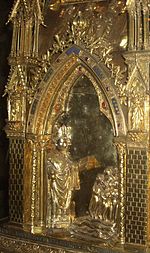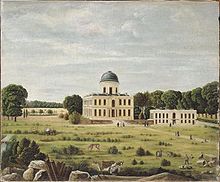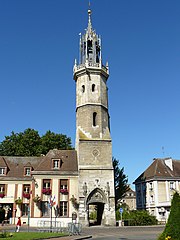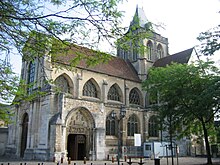Evreux
| Evreux | ||
|---|---|---|

|
|
|
| region | Normandy | |
| Department | Eure ( prefecture ) | |
| Arrondissement | Évreux ( sub-prefecture ) | |
| Canton |
Évreux-1 (main town) Évreux-2 (main town) Évreux-3 (main town) |
|
| Community association | Evreux Portes de Normandie | |
| Coordinates | 49 ° 1 ' N , 1 ° 9' E | |
| height | 57-147 m | |
| surface | 26.45 km 2 | |
| Residents | 47,733 (January 1, 2017) | |
| Population density | 1,805 inhabitants / km 2 | |
| Post Code | 27000 | |
| INSEE code | 27229 | |
| Website | www.evreux.fr | |
 Hôtel de ville , town hall |
||
Evreux is a French city with 47,733 inhabitants (at January 1, 2017) in the region of Normandy . In terms of population, it is the third largest city in the former Upper Normandy . Évreux is the prefecture of the Eure department . The inhabitants are named after the Gallic tribe of the Eburovices Ébroïciens .
geography
Évreux is located 88 kilometers northwest of Paris, 47 kilometers south of Rouen and is crossed by the Iton River. The municipal area covers 2,645 hectares, the mean height is 102 meters above sea level , the Mairie stands at a height of 70 meters. In the southwest of the city lies the 4200 hectare forest Forêt d'Évreux . Neighboring municipalities of Évreux are Aviron in the northwest, Gravigny in the north, Angerville-la-Campagne in the south and Arnières-sur-Iton in the southeast.
Évreux is assigned to a type Cfb (according to Köppen and Geiger ) climate zone : warm, moderate rainy climate (C), fully humid (f), warmest month below 22 ° C, at least four months above 10 ° C (b). There is a maritime climate with a moderate summer.
history
Celts, Romans and Christians
Dolmens and menhirs in the municipality of Évreux show that there was a settlement in Celtic times. Évreux was the capital of the Eburovices and was then called Mediolanum or Mediolanum Aulercorum , it was first mentioned in a document by Claudius Ptolemy (around 100 to before 180) and was mentioned in the 3rd century in the Antonini itinerary . In the 3rd book De bello Gallico (57–56 BC) Gaius Iulius Caesar wrote that the Eburovices killed their Senate because it was against the war . They joined the Veneller revolt . After the murder of the senators, the Eburovices closed the city gates. Accordingly, Évreux was a fortified city at that time. However, there are no archaeological finds to support the thesis that Évreux already had regular city walls at that time. After a short-lived victory by the Gauls over Quintus Titurius Sabinus , the Aulerci area was reoccupied by the Romans.
In Gallo-Roman times (52 BC to 486 AD), Évreux was located at the intersection of two Roman roads . The city belonged to the Roman province of Gallia Lugdunensis . A theater and thermal baths were built between AD 41 and 54 . In 1890 a deposit of over 100,000 coins from the time of the Imperial Crisis of the 3rd century was discovered. The coins were packed in leather bags and weighed a total of 340 kilograms. Another indication of the effects of the imperial crisis is the fire in the area between rue de Saint-Louis and allée des Soupirs . The neighborhood burned down after 260 and was never rebuilt. The picture is similar at the archaeological site in rue de la Harpe . This part of Mediolanum was abandoned in the last quarter of the 3rd century and only used again in the Middle Ages , this time as a cemetery. In Gallo-Roman times, the cemetery was in the southeast of the city. It was used until the Middle Ages. In the 3rd century, the city wall covered an area of around 8 hectares.
The Holy Taurinus († at the beginning of the 5th century.) Is regarded as bishop of Evreux and evangelized the Eburovices. However, nothing is known about the first Christian buildings; the next archaeological finds date from the Carolingian period (8th to 10th centuries).
middle Ages
The Merovingian king Clovis I (466–511) conquered Évreux. He held the First Council of Orléans in 511 , in which Maurusius, the first "ordinary" bishop of Évreux, participated. The bishop Laudulfus (after 585) is also a saint.
Around 892, Rollos Normans besieged, conquered and sacked the city. In 990, Évreux became the seat of a county of the Dukes of Normandy . In 1118 the county fell to the house of Montfort-l'Amaury through marriage . Henry I of England wanted to prevent this and had the city occupied. It was besieged and captured by the rightful Count of Évreux, the Count of Anjou and the Count of Flanders . The houses and churches were looted. The following year the city was retaken by the English, who set the city on fire. They had not succeeded in taking the castle of Evreux.
1193 ceded Jean Plantagenêt (1167-1216) Verneuil-sur-Avre and Évreux to Philip II of France (1165-1223). On the return of Richard the Lionheart (1157–1199) in 1194, Philip II returned Évreux to Jean Plantagenêt and besieged Verneuil. Philip II kept the castle of Évreux, on which a garrison was stationed. Jean Plantagenêt then organized a feast for the French and had them massacred. He had the heads of the killed soldiers impaled on the towers of the city walls. Thereupon Philip II ended the siege of Verneuil and marched with his troops to Évreux, which he set on fire, many residents were killed. In 1199 he set fire to Évreux again.
In the 13th century, Évreux experienced a period of growth thanks to the local textile industry . Mathieu des Essarts bought the Saint-Germain fief in 1285 and had a mansion built there. When he became bishop in 1299, he gave the fief and manor house to the diocese of Évreux . In 1315 the fief and mansion fell to the county. From 1328 to 1404 the Counts of Évreux were also kings of Navarre . In 1384 the mansion was restored, now also called the Navarre Manor .
Modern times
In 1441 French troops under the command of Robert des Flocques took the city in the course of the Hundred Years War (1337-1453). For Pierre de Brézé , the title "Count of Évreux" was revived - although it was not inheritable. The county was actually returned to the French king in 1404 by Charles the Noble . In 1462 King Ludwig XI. restore the castle of Évreux and sell the Navarre fief.
In the battle of Montlhéry on July 16, 1465, Jacques de Flocques, the Bailli , and Pierre de Brézé, the Count of Évreux, fell. They had on the side of Louis XI. fought against the Ligue du Bien public . The county of Évreux was therefore dissolved again. It was rumored that the count had been killed by the king's people. Therefore Jeanne Crespin, the count's widow, let Jean II de Bourbon and his troops and thus the Ligue du Bien public into the city on the night of September 27-28, 1465 . The Ligue also occupied Rouen Castle and used that as leverage. Accordingly, Évreux was awarded in the Treaty of Conflans on October 5, 1465 Charles de Valois , who was a member of the Ligue and brother of the king. The new owner had the city plundered. The city sent three representatives to the Estates General in Tours in 1468 , demanding that Normandy be returned to the king's possession. On November 9, 1469, Normandy really returned to the Crown. At the Échiquier de Rouen , the highest independent court in Normandy, was ordered by Louis XI. smash the duke's ring.
From 1520 the Reformation found its way into the département. In 1540, Francis I of France (1494-1547) tried to establish an inquisition court in Évreux , since Pope Paul III. tried to introduce the Inquisition to fight the Reformation in France. The inhabitants of Normandy opposed these efforts and the Inquisition Court was dissolved again. In 1555 a monk from the Notre-Dame du Parc priory in Harcourt was burned at the stake in Évreux for heresy . Several Protestants then met in the cemetery at the Saint-Adrien chapel and damaged a statue and the cemetery cross. In 1559 the first official Reformed church was established in Évreux. It lasted until the Edict of Nantes was repealed with the Edict of Fontainebleau in 1685.
Before the Battle of Ivry in 1590 Armand de Gontaut, seigneur de Biron (1524–1592), conquered the city. During the Fronde (1648–1653) it was conquered by royal troops. After the owner of the fief Navarre was murdered near Miserey , his daughter sold the property in 1665 to Frédéric-Maurice de La Tour d'Auvergne , Duke of Bouillon . His son Godefroy-Maurice de La Tour d'Auvergne had a castle built on the fiefdom of Navarre from 1679 to 1686 according to plans by Jules Hardouin-Mansart .
Modern
During the French Revolution (1789-1799) parts of Évreux were destroyed, although the city was positive about the reforms. François-Nicolas-Léonard Buzot (1760–1794) represented Évreux in the Estates General from 1789 and in the National Convention .
In 1836 the new owner had the 17th century Navarre Castle demolished and a factory built on the site. Today the hippodrome of Évreux is located there . The castle and the gardens designed by André Le Nôtre are easy to see on aerial photographs .
In the Franco-Prussian War (1870–1871), Évreux was bombed by Prussian troops in November 1870 and was finally occupied until December.
During the Second World War (1939-1945), Évreux was significantly destroyed by bombing . In the bombing by the Luftwaffe in June 1940, 87 civilians died and 135 French and British soldiers were also killed. 210 civilians died in the Allied bombardment on June 12, 1944. The bombing continued in July and August 1944, but only claimed six victims. On August 23, 1944, Évreux was liberated by the 1st US Army .
Population development
| year | 1962 | 1968 | 1975 | 1982 | 1990 | 1999 | 2006 | 2016 |
| Residents | 36,695 | 42,550 | 47,412 | 46,045 | 49.103 | 51,198 | 51,239 | 48,899 |
| Sources: Cassini and INSEE | ||||||||
Town twinning
- Rugby , United Kingdom (since 1959)
- Rüsselsheim am Main , Federal Republic of Germany (since 1961)
- Djougou , Benin (since 1989)
- Kaschira , Russia (since 1994)
Culture and sights
Gardens and green spaces
Évreux is represented with three flowers in the Conseil national des villes et villages fleuris (National Council of Flowered Cities and Villages). The "flowers" are awarded in the course of a regional competition, whereby a maximum of three flowers can be achieved.
In 1985 the 80 kilometer long railway line Évreux - Le Neubourg - Honfleur was closed. In the forest of Évreux, across the Iton to the forest of Saint-Michel, the railway line has been converted into a bicycle and hiking trail, 2.7 kilometers long and called Ligne verte ('green line'). About the way chemin de Valeme is Ligne verte with the 18-hole golf course connected the city.
The garden of the Capuchin monastery is now a public park. It is called Parc François Mitterrand and consists of two parts, one part is laid out in the style of a baroque garden, the other part as an English landscape garden . The park is home to magnolias , ginkgos , black mulberries , coastal redwoods , cedar trees , handkerchief trees , and fig trees , among others . In greenhouses there are orange trees , cacti , orchids , ferns and other plants on over 300 m² . Events for children and exhibitions are held in the orangery , which was built in 1843 .
The Parc de Trangis is located between the La Madeleine district and the Évreux forest. The area is 18 hectares. In 1982 the city of Évreux purchased the property, which includes an 18th century castle. The park offers extensive lawns for picnics , a mini golf course and a botanical nature trail , the entrance halls of the castle can be rented for parties.
Buildings
Évreux is an old diocese with a stately bishopric. The bishopric with its outbuildings and gardens is classified as a site classé (cultural and natural monument) and today houses the city museum. The current buildings date from the 15th and 18th centuries.
The Gothic cathedral and the bell tower of the diocese are also worth seeing. Both have been protected as Monument historique (historical monument ) since 1862 . An original cathedral was Romanesque and was consecrated in 1076. In 1119 it was destroyed by the fire caused by Heinrich I. It was rebuilt in 1140, and burned again in 1194 and 1198. It was built in its current form in the 13th century. The windows date from the 13th and 17th centuries. In 1475 the spire was built. Relics of Saints Barbara of Nicomedia and Maximus of Evreux were placed under the roof . Barbara von Nicomedia was supposed to protect the building from lightning and fire.
The municipal theater was built in 1901 by the architect Léon Legendre. He won a city competition with his design in 1897. The theater opened in 1903. It is owned by the city. In 2002, the painting and stucco of the foyer designed by Charles Denet was entered in the additional directory of the Monuments historiques.
In four streets there are still listed remains of the ramparts from the 3rd and 4th centuries.
Monasteries
The altar of the Saint-Taurin abbey church is one of the most splendid gilded altars in medieval France. The abbey was founded by Duke Richard I (935–996). From 1642 to 1793 it was inhabited by masons . In 1793 the abbey was sold. The church and the remains of the abbey are classified as Monument historique. The church square and the trees there are classified as site classé.
The old convent of the Cordeliers is the last remaining medieval Franciscan building in Normandy . The monastery was founded in 1260, restored in the 14th century after a fire and badly damaged in the 19th century. In 1994 it was partially entered in the additional register of historical monuments (inscrit MH) , it is privately owned.
The old Ursuline monastery was built in the 17th century. After the monastery was dissolved, it was used by the state as a gendarmerie and barracks . It was entered in the supplementary register of historical monuments in 1975.
The old Capuchin monastery was built in the 17th century. For many years it served as a grammar school ; today it houses a music school . The cloister was listed as a historical monument in 1931; apart from a brick building, the houses around the cloister were entered in the supplementary list of historical monuments in 1963.
Economy and Infrastructure
Protected Geographical Indications (IGP) apply to pork (Porc de Normandie) , poultry (Volailles de Normandie) and cider (Cidre de Normandie and Cidre normand) in the municipality .
A major employer is the military, which operates the Évreux-Fauville military airfield on the territory of neighboring municipalities to the east .
Évreux has a train station on the Paris – Cherbourg railway line ; the journey time to Paris Gare Saint-Lazare is less than an hour.
Sports
With the Athletic Club Évreux , the city has a traditional sports club, whose football teams have played in the first (women) and second (men) leagues in France. In the 2010s, the club was named after a merger Évreux FC 27 .
Personalities
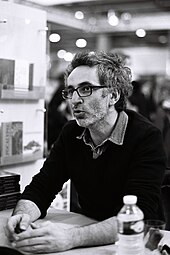
sons and daughters of the town
- Charles II of Navarre (1332–1387), Count of Évreux and King of Navarre
- Peter of Navarre (1366–1412), son of Charles II, Count von Mortain
- Jacques François de Chambray (1687–1750), Grand Cross Knight of the Order of Malta, Vice-Admiral and Commander of the galleys
- Nicolas de Bonneville (1760–1828), publicist and writer
- François-Nicolas-Léonard Buzot (1760–1794), revolutionary
- Louis-Auguste Desmarres (1810-1882), French ophthalmologist
- Léon Walras (1834-1910), economist
- Roger Rochard (1913–1993), long-distance runner
- Yves Henry (* 1959), classical pianist and composer
- Didier Courrèges (* 1960), riding instructor at the National Equestrian School in Saumur , eventing rider and Olympic champion
- Vincent Delerm (* 1976), singer, songwriter and composer
- Olivier Patience (* 1980), tennis player
- Guillaume Gauclin (* 1981), soccer goalkeeper
- Bernard Mendy (born 1981), football player
- Mathieu Bodmer (* 1982), football player
- Julien Duval (* 1990), racing cyclist
- Esteban Ocon (* 1996), racing driver
- Samuel Grandsir (* 1996), football player
- Dayot Upamecano (* 1998), football player
Personalities who have worked on site
- Guillaume Costeley (* around 1531 in Pont-Audemer , † 1606 in Évreux), was a French organist and composer who moved to Évreux around 1570 and lived and worked there until his death.
- Jacques Duphly (* 1715; † 1789), harpsichordist , composer and organist, was organist at the Cathedral of Évreux from 1732 to 1734 in his youth.
- Jacques Gaillot (* 1935) was the Catholic Bishop of Évreux for 13 years.
literature
- Jean Mineray: Evreux . Histoire de la ville à travers les âges. Éditions Bertout, Luneray 1988, ISBN 2-86743-062-3 (French).
- André Plaisse: Évreux et les Ébroïciens au Temps de Louis XI . In: Société Libre de l'Eure (ed.): Connaissance de l'Eure . tape 4 . Évreux 1986 (French).
- A.-V. de Walle: Évreux et l'Eure pendant la guerre . Charles Herissey, Évreux 2000, ISBN 2-914417-05-5 (French, first published in 1946).
Web links
- Évreux in the Base Mémoire des Ministère de la culture (French)
Individual evidence
- ↑ a b c Ville d'Évreux. In: Annuaire-Mairie.fr. Retrieved September 4, 2012 (French).
- ^ A b c d e Daniel Delattre, Emmanuel Delattre: L'Eure, les 675 communes . Editions Delattre, Grandvilliers 2000, pp. 103-107 (French).
- ↑ Geographia II, 8,9: Mediolanion , work not read myself, it is named as a source by Mineray in Histoire de la ville à travers les âges .
- ↑ De Bello Gallico. 17.3. Work not read myself, it is named as a source by Mineray in Histoire de la ville à travers les âges .
- ↑ Jean Mineray: Evreux . Histoire de la ville à travers les âges. Éditions Bertout, Luneray 1988, ISBN 2-86743-062-3 , pp. 14 (French).
- ↑ Carte. In: Itinéraires Romains en France. Retrieved June 6, 2010 (French).
- ^ A b Dominique Cliquet: L'Eure . 27. In: Michel Provost, Academie des inscriptions et belles-lettres, Ministere de la culture (ed.): Carte Archéologique de la Gaule . Fondation Maison des Sciences de l'Homme, Paris 1993, ISBN 2-87754-018-9 , p. 44-46, 49 (French).
- ↑ Taurinus of Evreux. In: Ecumenical Lexicon of Saints. Retrieved June 6, 2010 (French).
- ↑ Saint Laudulf. In: Nominis. Église Catholique en France, accessed September 4, 2012 (French).
- ↑ a b c communes. (No longer available online.) In: eure.pref.gouv.fr. Prefectess of Eure, archived from the original on April 27, 2013 ; Retrieved October 9, 2012 (French).
- ^ A b c Franck Beaumont, Philippe Seydoux: Gentilhommières des pays de l'Eure . Editions de la Morande, Paris 1999, ISBN 2-902091-31-2 ( formally incorrect ) , p. 11-13 (French).
- ↑ André Plaisse: Evreux et les Ébroïciens au Temps de Louis XI . In: Société Libre de l'Eure (ed.): Connaissance de l'Eure . tape 4 . Évreux 1986, ISBN 2-904915-01-9 ( formally incorrect ) , p. 29, 33-35, 38, 40 (French).
- ↑ Pierre Le Brasseur: Histoire civile et ecclesiastique du comté d'Evreux, ou l'on voit tout ce qui s'est passé depuis la fondation de la monarchie, tant par rapport aux rois de France, qu'aux anciens ducs de Normandie, & aux rois d'Angleterre . François Barois, Paris 1722, p. 319 (French, books.google.fr ).
- ↑ Laurence Riviale: Le vitrail en Normandie entre Renaissance et Réforme (1517–1596) . In: Corpus Vitrearum . tape 7 . Presses Universitaires de Rennes, Rennes 2007, ISBN 978-2-7535-0525-4 , pp. 25-29 (French).
- ↑ Bernard Bodinier (ed.): L'Eure de la Préhistoire à nos jours . Jean-Michel Bordessoules, Saint-Jean-d'Angély 2001, ISBN 2-913471-28-5 , pp. 248 (French).
- ^ Jean-Noël Le Borgne, Véronique Le Borgne, Pascale Eudier, Annie Etienne: Archeologie Aérienne dans l'Eure . Ed .: Association Archéo 27. Page de Garde, Caudebec-les-Elbeuf 2002, ISBN 2-84340-230-1 , p. 75 .
- ↑ Alex Gardin: La guerre de 1870–1871 à Bernay . Les Éditions Page de Garde, Saint-Aubin-les-Elbeuf 1997, ISBN 2-84340-037-6 , p. 19, 43 (French, reprint, original from 1898).
- ↑ A.-V. de Walle: Évreux et l'Eure pendant la guerre . S. 200-214 .
- ↑ A.-V. de Walle: Évreux et l'Eure pendant la guerre . S. 144-152 .
- ^ Raymond Ruffin: Le Prix de la Liberté . Juin - août 44th Presses de la Cité, 1995, ISBN 2-258-03893-6 , p. 266 .
- ↑ Site officiel des Villes et Villages Fleuris, label de quality de vie et de development du tourisme vert. In: villes-et-villages-fleuris.com. Retrieved December 25, 2018 (French).
- ^ A b A. Blanchard, M. Delafenêtre, Lisa Pascual: Jardins en Normandie . Your. Connaissance des Jardins, Caen 2001, ISBN 2-912454-07-7 , pp. 20-24 (French).
- ↑ Bernard Verwaerde: A quels saints se vouer? ... dans l'Eure . les saints protecteurs et guérisseurs. Editions Page de Garde, Caudebec-lès-Elbeuf 2001, ISBN 2-84340-191-7 , p. 54 (French).
- ↑ a b Évreux. In: Base Mérimée. Ministère de la culture, accessed June 8, 2010 (French).
- ^ David Fiala, Nicole Jolivet: Le Puy de Musique d'Evreux. Université de Rouen, Center d'Études et de Recherche Éditer / Interpréter, accessed on June 6, 2010 (French).
- ↑ Denis Herlin: Duphly, Jacques. In: The music in past and present ( MGG ), personal part, vol. 5. Bärenreiter / Metzler, Kassel / Stuttgart 2001, col. 1631–1634, here: 1631. Also: Philippe Lescat: Biographie de Jacques Duphly (tabular). In: Jacques Duphly: Pièces de Clavecin - Premier Livre , 1744. Facsimile, ed. v. J. Saint-Arroman. Edition JM Fuzeau, Courlay 1990, p. IV.


